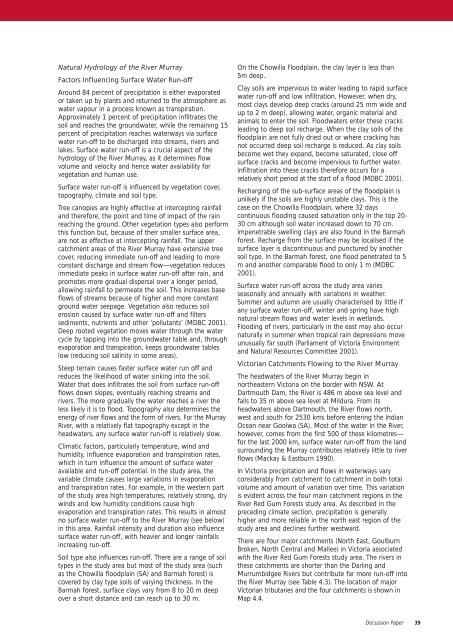Discussion Paper - Part A - Victorian Environmental Assessment ...
Discussion Paper - Part A - Victorian Environmental Assessment ...
Discussion Paper - Part A - Victorian Environmental Assessment ...
- No tags were found...
Create successful ePaper yourself
Turn your PDF publications into a flip-book with our unique Google optimized e-Paper software.
Natural Hydrology of the River MurrayFactors Influencing Surface Water Run-offAround 84 percent of precipitation is either evaporatedor taken up by plants and returned to the atmosphere aswater vapour in a process known as transpiration.Approximately 1 percent of precipitation infiltrates thesoil and reaches the groundwater, while the remaining 15percent of precipitation reaches waterways via surfacewater run-off to be discharged into streams, rivers andlakes. Surface water run-off is a crucial aspect of thehydrology of the River Murray, as it determines flowvolume and velocity and hence water availability forvegetation and human use.Surface water run-off is influenced by vegetation cover,topography, climate and soil type.Tree canopies are highly effective at intercepting rainfalland therefore, the point and time of impact of the rainreaching the ground. Other vegetation types also performthis function but, because of their smaller surface area,are not as effective at intercepting rainfall. The uppercatchment areas of the River Murray have extensive treecover, reducing immediate run-off and leading to moreconstant discharge and stream flow—vegetation reducesimmediate peaks in surface water run-off after rain, andpromotes more gradual dispersal over a longer period,allowing rainfall to permeate the soil. This increases baseflows of streams because of higher and more constantground water seepage. Vegetation also reduces soilerosion caused by surface water run-off and filterssediments, nutrients and other ‘pollutants’ (MDBC 2001).Deep rooted vegetation moves water through the watercycle by tapping into the groundwater table and, throughevaporation and transpiration, keeps groundwater tableslow (reducing soil salinity in some areas).Steep terrain causes faster surface water run off andreduces the likelihood of water sinking into the soil.Water that does infiltrates the soil from surface run-offflows down slopes, eventually reaching streams andrivers. The more gradually the water reaches a river theless likely it is to flood. Topography also determines theenergy of river flows and the form of rivers. For the MurrayRiver, with a relatively flat topography except in theheadwaters, any surface water run-off is relatively slow.Climatic factors, particularly temperature, wind andhumidity, influence evaporation and transpiration rates,which in turn influence the amount of surface wateravailable and run-off potential. In the study area, thevariable climate causes large variations in evaporationand transpiration rates. For example, in the western partof the study area high temperatures, relatively strong, drywinds and low humidity conditions cause highevaporation and transpiration rates. This results in almostno surface water run-off to the River Murray (see below)in this area. Rainfall intensity and duration also influencesurface water run-off, with heavier and longer rainfallsincreasing run-off.Soil type also influences run-off. There are a range of soiltypes in the study area but most of the study area (suchas the Chowilla floodplain (SA) and Barmah forest) iscovered by clay type soils of varying thickness. In theBarmah forest, surface clays vary from 8 to 20 m deepover a short distance and can reach up to 30 m.On the Chowilla Floodplain, the clay layer is less than5m deep.Clay soils are impervious to water leading to rapid surfacewater run-off and low infiltration. However, when dry,most clays develop deep cracks (around 25 mm wide andup to 2 m deep), allowing water, organic material andanimals to enter the soil. Floodwaters enter these cracksleading to deep soil recharge. When the clay soils of thefloodplain are not fully dried out or where cracking hasnot occurred deep soil recharge is reduced. As clay soilsbecome wet they expand, become saturated, close offsurface cracks and become impervious to further water.Infiltration into these cracks therefore occurs for arelatively short period at the start of a flood (MDBC 2001).Recharging of the sub-surface areas of the floodplain isunlikely if the soils are highly unstable clays. This is thecase on the Chowilla Floodplain, where 32 dayscontinuous flooding caused saturation only in the top 20-30 cm although soil water increased down to 70 cm.Impenetrable swelling clays are also found in the Barmahforest. Recharge from the surface may be localised if thesurface layer is discontinuous and punctured by anothersoil type. In the Barmah forest, one flood penetrated to 5m and another comparable flood to only 1 m (MDBC2001).Surface water run-off across the study area variesseasonally and annually with variations in weather.Summer and autumn are usually characterised by little ifany surface water run-off, winter and spring have highnatural stream flows and water levels in wetlands.Flooding of rivers, particularly in the east may also occurnaturally in summer when tropical rain depressions moveunusually far south (Parliament of Victoria Environmentand Natural Resources Committee 2001).<strong>Victorian</strong> Catchments Flowing to the River MurrayThe headwaters of the River Murray begin innortheastern Victoria on the border with NSW. AtDartmouth Dam, the River is 486 m above sea level andfalls to 35 m above sea level at Mildura. From itsheadwaters above Dartmouth, the River flows north,west and south for 2530 kms before entering the IndianOcean near Goolwa (SA). Most of the water in the River,however, comes from the first 500 of these kilometres—for the last 2000 km, surface water run-off from the landsurrounding the Murray contributes relatively little to riverflows (Mackay & Eastburn 1990).In Victoria precipitation and flows in waterways varyconsiderably from catchment to catchment in both totalvolume and amount of variation over time. This variationis evident across the four main catchment regions in theRiver Red Gum Forests study area. As described in thepreceding climate section, precipitation is generallyhigher and more reliable in the north east region of thestudy area and declines further westward.There are four major catchments (North East, GoulburnBroken, North Central and Mallee) in Victoria associatedwith the River Red Gum Forests study area. The rivers inthese catchments are shorter than the Darling andMurrumbidgee Rivers but contribute far more run-off intothe River Murray (see Table 4.3). The location of major<strong>Victorian</strong> tributaries and the four catchments is shown inMap 4.4.<strong>Discussion</strong> <strong>Paper</strong>39
















